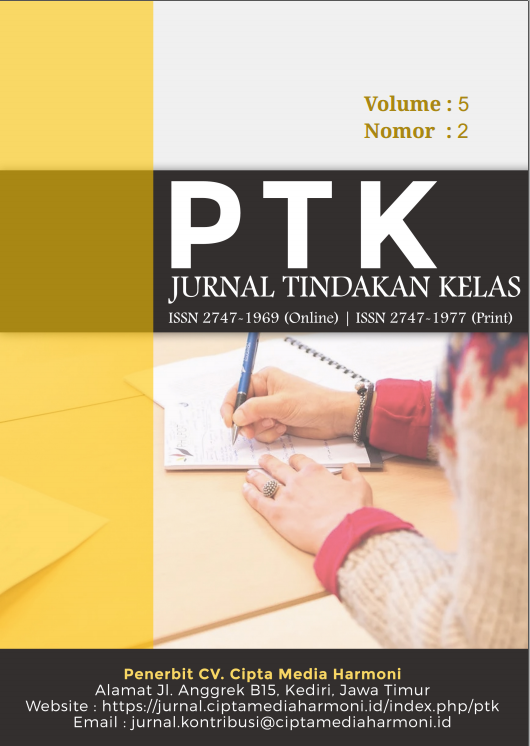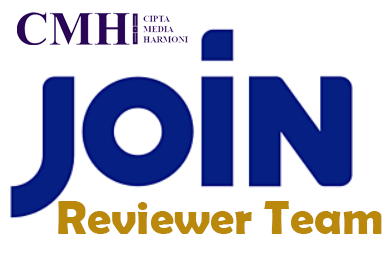Pengaruh Pendekatan Teks Cerita Bahasa Arab Terhadap Peningkatan Keterampilan Maharah Kalam Pada Pembelajaran Bahasa Arab Siswa Kelas VIII di MTs Al-Khairiyah Natar
DOI:
https://doi.org/10.53624/ptk.v5i2.533Keywords:
story text method, Arabic, kalam maharah skillsAbstract
The purpose of this study was to analyze the effect of Arabic story text method in improving maharah kalam skills in class VIII students of MTs Al-Khairiyah Natar. This study used a quantitative approach with a quasi-experiment research design, in which the experimental class (VIII A) consisting of 38 students and the control class (VIII B) consisting of 31 students became the research subjects. The instrument used was a test question that had been tested for validity and reliability. Data analysis techniques include N-gain test and hypothesis testing using Independent Sample T Test. The results showed that the average N-Gain of the experimental class was 0.62, which was categorized as a moderate improvement, while the average N-Gain of the control class was only 0.16, which was categorized as low. The results of hypothesis testing show the Sig (2-tailed) value ≤ P Value, which is 0.00 ≤ 0.05, which means that there is a significant effect of the Arabic story text method on improving maharah kalam in Arabic language learning in class VIII MTs Al-Khairiyah Natar.Downloads
References
Amanda, C. F., & Khan, J. (2024). The Influence of Internal and External Factors on Arabic Language Learning Interest among Arabic Language Education Students. Journal of Arabic Language Learning and Teaching (JALLT), 2(2), 89–100. https://doi.org/10.37641/jiakes.v12i3.1490 DOI: https://doi.org/10.23971/jallt.v2i2.178
Ames, H., Glenton, C., & Lewin, S. (2019). Purposive sampling in a qualitative evidence synthesis: A worked example from a synthesis on parental perceptions of vaccination communication. BMC Medical Research Methodology, 19(1), 1–9. https://doi.org/10.1186/s12874-019-0665-4 DOI: https://doi.org/10.1186/s12874-019-0665-4
Bilqish, A., Putri, A., Prastiwi, T. S., & Nasution, J. S. (2024). Evaluasi Pembelajaran Berbicara di Kelas Tinggi. JISPENDIORA Jurnal Ilmu Sosial Pendidikan Dan Humaniora, 3(2), 127–133. https://doi.org/10.56910/jispendiora.v3i2.1506 DOI: https://doi.org/10.56910/jispendiora.v3i2.1506
Cheng, M. M., & Chuang, H. H. (2019). Learning processes for digital storytelling scientific imagination. Eurasia Journal of Mathematics, Science and Technology Education, 15(2). https://doi.org/10.29333/ejmste/100636 DOI: https://doi.org/10.29333/ejmste/100636
Fauzi, M. F., & Anindiati, I. (2021). Improving the Motivation of Students in Arabic Language Learning through Learning Management System. Izdihar : Journal of Arabic Language Teaching, Linguistics, and Literature, 4(3), 257–274. https://doi.org/10.22219/jiz.v4i3.19110 DOI: https://doi.org/10.22219/jiz.v4i3.19110
Fkhururazi, S. N., Rahmat, N. H., Rahman, D. S. N. H. A., Sujak, S. F., & Hasan, C. A. (2023). Balancing Motivation and Fear in Learning: The Case for Learning Arabic Language. International Journal of Academic Research in Business and Social Sciences, 13(11), 1070–1084. https://doi.org/10.6007/ijarbss/v13-i11/19415 DOI: https://doi.org/10.6007/IJARBSS/v13-i11/19415
Gholamrezaie, M., & Nejad, A. M. (2023). Barrasi-ye Keyfi-ye Ta'sir-e Amoozesh-haye Mobtani bar Dastan-guyi bar Taqviat-e Khalaqiyat-e Danesh-amoozan. Journal of Study and Innovation in Education and Development, 1402, 19–28.. DOI: https://doi.org/10.61838/jsied.3.3.3
Handley, M. A., Lyles, C. R., McCulloch, C., & Cattamanchi, A. (2018). Selecting and Improving Quasi-Experimental Designs in Effectiveness and Implementation Research. Annual Review of Public Health, 39, 5–25. https://doi.org/10.1146/annurev-publhealth-040617-014128 DOI: https://doi.org/10.1146/annurev-publhealth-040617-014128
Kawar, K., Saiegh-Haddad, E., & Armon-Lotem, S. (2023). Text complexity and variety factors in narrative retelling and narrative comprehension among Arabic-speaking preschool children. First Language, 43(4), 355–379. https://doi.org/10.1177/01427237221149800 DOI: https://doi.org/10.1177/01427237221149800
Khoir, A., Jessenianta, A. K., & Rohmana, W. I. M. (2024). Utilizing Narrative Text as a Means of Incorporating Literature into English Language Teaching to Enhance Students’ Listening and Speaking Skills. JETLEE : Journal of English Language Teaching, Linguistics, and Literature, 4(1), 68–77. https://doi.org/10.47766/jetlee.v4i1.2251 DOI: https://doi.org/10.47766/jetlee.v4i1.2251
Khresha, I. H. M. A. (2022). Fa‘iliyyat al-Hikayah fi Tahsin Maharat (al-Istima‘ wa al-Tahadduth wa al-Talaqah al-Lughawiyyah) lada Tullab al-Saff al-Thani al-Asasi fi al-Urdun. Journal of Educational and Psychological Sciences, 6(11), 95–109. https://doi.org/10.26389/ajsrp.c300821 DOI: https://doi.org/10.26389/AJSRP.C300821
Krishnan, P. (2019). A review of the non-equivalent control group post-test-only design. Nurse Researcher, 26(2), 37–40. https://doi.org/10.7748/nr.2018.e1582 DOI: https://doi.org/10.7748/nr.2018.e1582
Lăpădat, L. C., & Lăpădat, M. M. (2024). The Importance of Motivation in Foreign Language Learning. Scientific Bulletin of the Politehnica University of Timişoara Transactions on Modern Languages, 22(1), 142–152. https://doi.org/10.59168/vgle2734 DOI: https://doi.org/10.59168/VGLE2734
Lubis, I., Lessy, Z., & Hasan, M. N. (2022). The Students’ Difficulties in Practicing Arabic’S Maharah Kalam At the Arabic Language Education Department Iain Langsa. El-Tsaqafah : Jurnal Jurusan PBA, 21(1), 1–14. https://doi.org/10.20414/tsaqafah.v21i1.4690 DOI: https://doi.org/10.20414/tsaqafah.v21i1.4690
Mahmud, H. S., Sa’id, Z. H., & Muhyiddn, N. K. (2024). The Role Of Arabic Language And Its Impact In Improving Education Among Children. Aqlamuna: Journal of Educational Studies, 1(2), 186–196. https://doi.org/10.58223/aqlamuna.v1i2.281 DOI: https://doi.org/10.58223/aqlamuna.v1i2.281
Makrifah, N. (2023). Development of Role Play Method To Improve the Ability of Speaking Arabic in Islamic Elementary School. Al-Ibrah : Jurnal Pendidikan Dan Keilmuan Islam, 8(1), 53–66. https://doi.org/10.61815/alibrah.v8i1.248 DOI: https://doi.org/10.61815/alibrah.v8i1.248
Maulaya, M. D. A., Ubaidillah, B., & Özgür, H. (2024). Istratijiyyah Taqdim al-Qissah li-Tarqiyat Maharat al-Kalam fi al-Ma‘had al-Salafi Hamalat al-Qur’an Joko Rata Jombang. Bilingua, 1(2), 30–38. DOI: https://doi.org/10.33752/bilingua.v1i2.6695
Mubaligh, A., Sari, R. R., & Novitasari, E. D. (2022). Strategies to Improve Arabic Speaking Skills for Islamic. Izdihar : Journal of Arabic Language Teaching, Linguistics, and Literature, 5(3), 251–264. DOI: https://doi.org/10.22219/jiz.v5i3.21716
Oviedo Guado, N. G., & Mena Mayorga, J. I. (2021). Communicative language teaching approach in the development of speaking skill. Ciencia Digital, 5(4), 6–26. https://doi.org/10.33262/cienciadigital.v5i4.1865 DOI: https://doi.org/10.33262/cienciadigital.v5i4.1865
Pikri, F. (2022). The Role of the Language Environment in Improving Arabic Learning Abilities. International Journal of Science and Society, 4(2), 346–354. https://doi.org/10.54783/ijsoc.v4i2.478 DOI: https://doi.org/10.54783/ijsoc.v4i2.478
Rafat, A. H., Rahimi, M. A., Atifnigar, H., & Safi, A. B. (2023). The Status of the Arabic Language in Afghanistan: Retrospect and Prospects. European Journal of Theoretical and Applied Sciences, 1(5), 1016–1024. https://doi.org/10.59324/ejtas.2023.1(5).88 DOI: https://doi.org/10.59324/ejtas.2023.1(5).88
Rahmadhania, S. N., Chaerul, A., & Ahmad, Y. B. (2022). Exploring Students’ Experiences of Story Telling Technique in English Speaking Learning in Junior High School. Edumaspul: Jurnal Pendidikan, 6(1), 546–555. https://doi.org/10.33487/edumaspul.v6i1.1952 DOI: https://doi.org/10.33487/edumaspul.v6i1.1952
Rahmawati, N. M. (2020). The Implementation of Short Story in Enhancing Student’s Vocabularies. Wanastra: Jurnal Bahasa Dan Sastra, 12(2), 236–241. https://doi.org/10.31294/w.v12i2.8668 DOI: https://doi.org/10.31294/w.v12i2.8668
Rashidovich, H. S., Alisherovna, S. K., & Nigina, G. (2022). FORMATION OF SPEAKING SKILLS OF STUDENTS THROUGH VARIOUS. 5, 108–111.
Rosmitha, T. A., & Ammar, F. M. (2022). Student Responses to the Application of the Storytelling Method in Arabic Speaking Skills for High School Students. Indonesian Journal of Islamic Studies, 14, 6–14. DOI: https://doi.org/10.21070/ijis.v8i0.1627
Utami, N. C. M., Azzahra, S. F., & Nuryani, N. (2023). Analysis of Speaking Skills with Storytelling Method in Indonesian Language Learning in Elementary Schools. Edunesia: Jurnal Ilmiah Pendidikan, 4(1), 358–371. https://doi.org/10.51276/edu.v4i1.303 DOI: https://doi.org/10.51276/edu.v4i1.303
Downloads
Published
How to Cite
Issue
Section
License
Copyright (c) 2025 Ahmad Nur Mizan Mizan, Ainun Mardhiyyah, Syarifudin Basyar

This work is licensed under a Creative Commons Attribution-ShareAlike 4.0 International License.
1. Hak cipta atas artikel apa pun dipegang oleh penulisnya.
2. Penulis memberikan jurnal, hak publikasi pertama dengan karya yang dilisensikan secara bersamaan di bawah Lisensi Atribusi Creative Commons yang memungkinkan orang lain untuk membagikan karya dengan pengakuan atas kepenulisan dan publikasi awal karya tersebut dalam jurnal ini.
3. Penulis dapat membuat pengaturan kontrak tambahan yang terpisah untuk distribusi non-eksklusif dari versi jurnal yang diterbitkan dari karya tersebut (misalnya, mempostingnya ke repositori institusional atau menerbitkannya dalam sebuah buku), dengan pengakuan dari publikasi awalnya di jurnal ini.
4. Penulis diizinkan dan didorong untuk memposting karya mereka secara online (misalnya, di repositori institusional atau di situs web mereka) sebelum dan selama proses pengiriman, karena hal itu dapat mengarah pada pertukaran yang produktif, serta kutipan yang lebih awal dan lebih besar dari karya yang diterbitkan.
5. Artikel dan materi terkait yang diterbitkan didistribusikan di bawah Lisensi Internasional Creative Commons Attribution-ShareAlike 4.0















